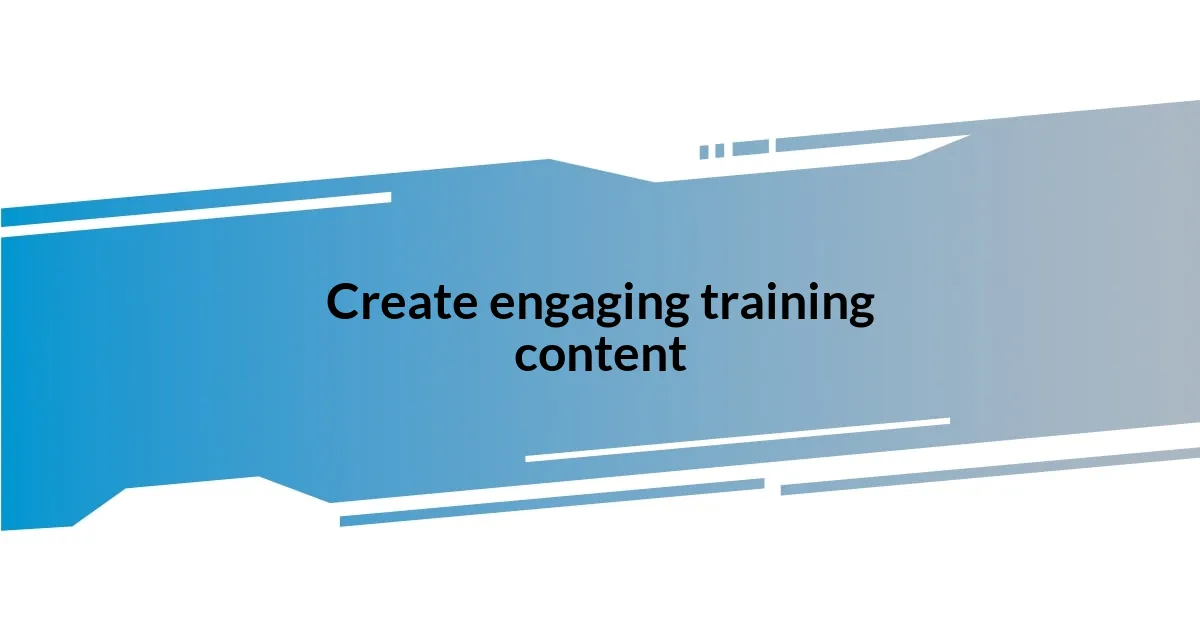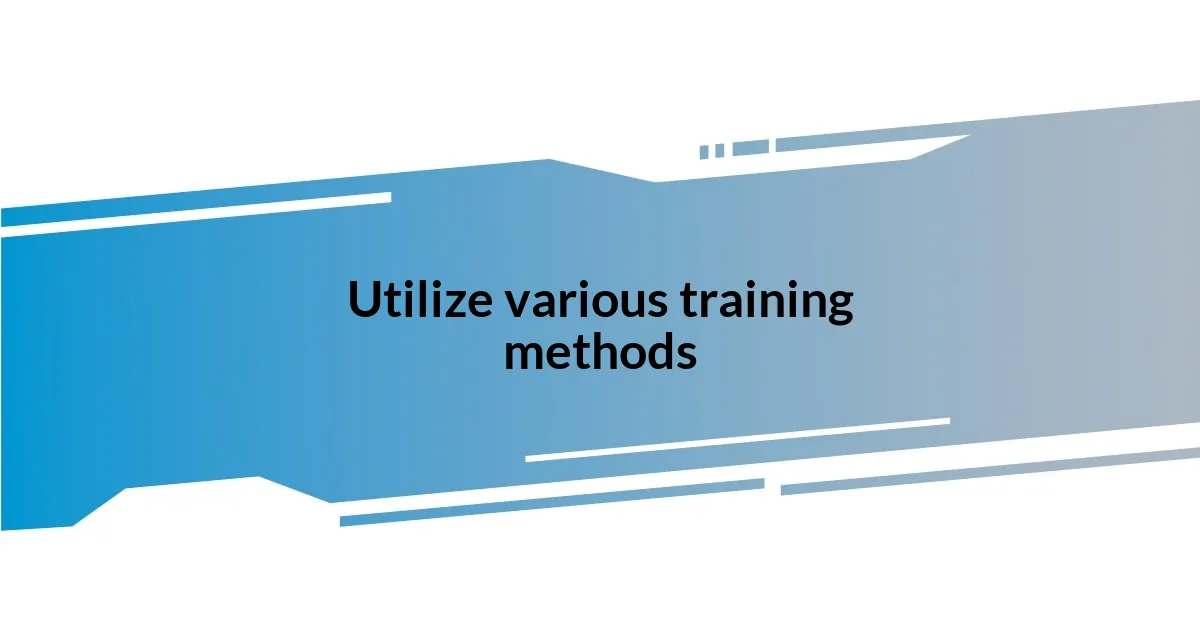Key takeaways:
- Clarify training goals from the start to align expectations and improve effectiveness.
- Choose appropriate training materials that cater to various learning styles and the audience’s skill levels.
- Incorporate hands-on practice to enhance understanding and build confidence among learners.
- Gather feedback continuously to refine training approaches and foster a sense of community among participants.

Understand the training goals
To truly understand the training goals, it’s crucial to clarify the desired outcomes from the very beginning. I remember when I first delved into user training; I was surprised by how often these goals were glossed over. Establishing clear objectives not only aligns everyone involved but also sets a benchmark for success.
What happens when you neglect to define your training goals? I learned this the hard way during a previous project where the team had differing expectations. This lack of alignment led to confusion and frustration, ultimately making the training less effective than it could have been. By determining the specific skills or knowledge the users should acquire, you pave the way for a more structured and engaging learning experience.
One key aspect to consider is the audience. Have you thought about who will be trained and what they need? I often find that tailoring the training to address the specific requirements and challenges of the users makes a significant difference. For instance, when training a group of executives versus new employees, the training goals—and methods—should differ considerably. Understanding the training goals not only informs your strategy but also ensures that you remain focused on what truly matters for your users.

Choose the right training materials
Choosing the right training materials can significantly influence the effectiveness of your user training programs. I vividly recall a time when I opted for overly technical materials. The intended audience struggled to relate, and the enthusiasm quickly faded. It’s essential to gauge the comfort level and experience of your users to ensure the materials resonate with them.
When evaluating training resources, a mix of formats often works best. For example, blending videos, written guides, and interactive sessions engages different learning styles. I once developed a training session that included a hands-on workshop alongside an online module. The feedback was overwhelmingly positive; the participants appreciated the variety and said it made the learning process more enjoyable and effective.
Consider your goals and the specific context of the training. Do you want to provide foundational knowledge or advanced skills? I learned firsthand how crucial it is to select materials that align with the users’ skill levels. Getting it right matters; it can make the difference between an informative session and a frustrating experience.
| Type of Material | Pros |
|---|---|
| Videos | Visual engagement, easy to digest |
| Written Guides | Can be referenced later, detailed information |
| Interactive Sessions | Hands-on experience, boosts retention |

Create engaging training content

Create engaging training content
Creating engaging training content is vital for maintaining learners’ interest and ensuring retention of knowledge. I once conducted a session that incorporated storytelling techniques, which transformed an otherwise dry subject into an enchanting narrative. The participants became invested in the material, and their enthusiasm was palpable—it was a reminder of how storytelling can bridge gaps in understanding and foster a connection with the content.
To achieve this, consider the following tips:
- Use relatable examples that mirror real-life scenarios your audience might encounter.
- Incorporate interactive elements such as quizzes or discussions to encourage active participation.
- Break complex information into bite-sized chunks to avoid overwhelming your learners.
- Vary your tone and pacing to keep the energy dynamic throughout the training.
I’ve found that incorporating humor—even just a light joke here and there—can also lighten the mood and make the training feel less like a chore. The right balance of engagement and information can turn a training session from mundane to memorable, leaving a lasting impact on your audience.

Utilize various training methods
Utilizing various training methods is a game-changer in user training. I remember a time when I organized a series of mock problem-solving sessions alongside traditional lectures. The shift in dynamics was incredible; suddenly, participants were not just passive listeners. They engaged with each other, bouncing ideas off one another, and this collaboration spurred creativity and deeper understanding.
It’s fascinating how different methods can resonate with distinct individuals. For instance, during one training workshop, I partnered written materials with an interactive app that allowed users to practice skills in real-time. At first, I was hesitant about the app’s effectiveness, but seeing participants light up as they solved challenges made me appreciate the value of integrating technology into training. It’s that spark of connection that can sometimes elevate the learning experience beyond what a single approach can achieve.
When planning training, it’s important to keep an open mind about what may work best for your audience. Have you ever considered how embracing diverse teaching styles could cater to various learning preferences? From auditory to kinesthetic learners, I’ve witnessed firsthand how tailored methods promote not just comprehension, but confidence among users. Each participant brings a unique background and perspective, and recognizing that can transform your training from a one-size-fits-all experience to a memorable, personalized journey.

Incorporate hands-on practice
When I think about effective user training, one essential aspect that stands out is the value of hands-on practice. I still recall a workshop I facilitated on data entry software, where I encouraged participants to work on real-life projects instead of just following along with slides. The moment everyone got their hands dirty, diving into actual case studies, I could see the light bulbs flick on. They were no longer passive learners; they were problem solvers in action, and that engagement was palpable.
Hands-on practice not only enhances understanding but also builds confidence. I remember one participant, Sarah, who initially felt overwhelmed by the software’s complexity. But once she started navigating the program herself, her anxiety transformed into excitement. I could see her enthusiasm grow with each small victory, like when she successfully generated her first report. Isn’t it incredible how much confidence can emerge from simply allowing learners to explore and experiment?
It’s vital to create a safe environment where participants feel free to make mistakes. I emphasize this during training sessions by sharing my own early missteps in various applications. When I first used that same data entry software, I couldn’t figure out how to save my work! I often ask my audience if they’ve ever faced similar hiccups, and more times than not, it sparks a helpful discussion. It’s reassuring to realize that learning is a journey filled with stumbles, and incorporating hands-on practice can make that journey not just informative but also enjoyable.

Measure training effectiveness
To truly assess the effectiveness of user training, it’s essential to gather feedback from participants. One time, after completing a comprehensive training on project management tools, I created a simple anonymous survey. The insights were eye-opening! Many users shared thoughts I hadn’t considered, like the pacing of the material or specific features they struggled with. This reality check helped me refine future sessions and cater to their needs better. Have you thought about how valuable this kind of direct feedback can be?
Another powerful method to measure training effectiveness is the observation of user application in real scenarios. I once observed a team two weeks after a training on customer service techniques, and I was amazed by their transformations. Just watching them confidently handle customer inquiries was validation of my training efforts. Seeing learners utilize what they absorbed and thrive in their roles? That’s the priceless moment that every trainer hopes for.
Additionally, tracking performance metrics before and after training can reveal significant progress. I remember collaborating with a sales team and comparing their numbers from the month before training to the month after. The boost in closing rates was staggering, and discussing the results with the team sparked a renewed dedication to implementing the techniques we covered. Isn’t it rewarding to not just see improvement but also to witness learners taking ownership of their growth as a result of your training?

Gather feedback for improvement
Gathering feedback for improvement is a cornerstone of effective user training. After one particularly intense training session on software navigation, I encouraged participants to share their thoughts openly. One attendee, Mark, noted that certain areas were unclear, which prompted a discussion I hadn’t anticipated. The collective insights not only improved my approach but also fostered a sense of community among the group—everyone felt like they had a stake in the training process.
I’ve also found value in informal feedback methods. After a rollout of new communication tools, I created a simple chat group where users could share their experiences and challenges. One evening, while sipping tea, I read a message from Susan about a feature that didn’t work as expected and how it affected her workflow. That real-time feedback was invaluable; it made me realize how crucial it is to keep the lines of communication open even after the formal training ends. How often do we miss golden opportunities to enhance our training based on simple conversations?
Finally, I advocate for implementing a feedback loop where participants can see how their suggestions are addressed. During a follow-up session, I showcased a few tweaks I made based on their input. When I noticed their nodding heads and smiles of recognition, it became crystal clear that they felt heard and valued. Isn’t that what we all want—to feel that our voice matters? By actively seeking and incorporating feedback, we not only improve our training methods but also nurture a more engaged and confident group of learners.